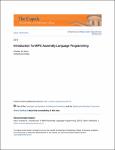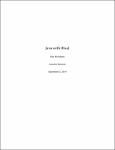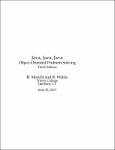Search
Author
- McFadyen, Ron (3)
- Jørgen Hole, Kjell (1)
- Kann, Charles (1)
- Linge, Svein (1)
- next >
Subject
- Java (5)
- programming (4)
- BlueJ (2)
- programmer (2)
- next >
Has File(s)
- true (9)
Search Results
"I never seemed to find the perfect data-oriented Python book for my course, so I set out to write just such a book. Luckily at a faculty meeting three weeks before I was about to start my new book from scratch over the holiday break, Dr. Atul Prakash showed me the Think Python book which he had used to teach his Python course that semester. It is a well-written Computer Science text with a focus on short, direct explanations and ease of learning.The overall book structure has been changed to get to doing data analysis problems as quickly as possible and have a series of running examples and exercises about data analysis from the very beginning.
Chapters 2–10 are similar to the Think Python book, but there have been major changes. Number-oriented examples and exercises have been ... |
"This book was written to introduce students to assembly language programming in MIPS. As with all assemblylanguage programming texts, it covers basic operators and instructions, subprogram calling, loading andstoring memory, program control, and the conversion of the assembly language program into machine code.
However this book was not written simply as a book on assembly language programming. The larger purposeof this text is to show how concepts in Higher Level Languages (HLL), such as Java or C/C++, arerepresented in assembly. By showing how program constructs from these HLL map into assembly, theconcepts will be easier to understand and use when the programmer implements programs in languages likeJava or C/C++. Concepts such as references and variables, registers, binary an... |
This text is a free introductory text that introduces MS Access and relational database design. The motivation is to support a second-year course on database systems which, to the student, is either a service course providing an introduction to database concepts, or, as a prerequisite for more advanced study in the field. |
This book is Part II of a two-part set that introduces the Java programming language. The text assumes the student will be using the BlueJ development environment and provides some introductory BlueJ material. Our experience has been that BlueJ is easy to learn and provides a good programming environment for the beginner programmer. |
This book is Part I of a two-part set that introduces the Java programming language. The text assumes the student will be using the BlueJ development environment and provides some introductory BlueJ material. Our experience has been that BlueJ is easy to learn and provides a good programming environment for the beginner programmer. |
This book introduces a novel approach to the design and operation of large ICT systems. It views the technical solutions and their stakeholders as complex adaptive systems and argues that traditional risk analyses cannot predict all future incidents with major impacts. To avoid unacceptable events, it is necessary to establish and operate anti-fragile ICT systems that limit the impact of all incidents, and which learn from small-impact incidents how to function increasingly well in changing environments.
The book applies four design principles and one operational principle to achieve anti-fragility for different classes of incidents. It discusses how systems can achieve high availability, prevent malware epidemics, and detect anomalies. Analyses of Netflix’s media streaming solut... |
"We have designed this third edition of Java, Java, Java to be suitable for a typical Introduction to Computer Science (CS1) course or for a slightly more advanced Java as a Second Language course. This edition retains the “objects first” approach to programming and problem solving that was characteristic of the first two editions. Throughout the text we emphasize careful coverage of Java language features, introductory programming concepts, and object-oriented design principles.
The third edition retains many of the features of the first two editions, including:
Early Introduction of Objects
Emphasis on Object Oriented Design (OOD)
Unified Modeling Language (UML) Diagrams
Self-study Exercises with Answers
Programming, Debugging, and Design Tips.
From the Java Library Sec... |
This book presents computer programming as a key method for solving mathematical problems. There are two versions of the book, one for MATLAB and one for Python. The book was inspired by the Springer book TCSE 6: A Primer on Scientific Programming with Python (by Langtangen), but the style is more accessible and concise, in keeping with the needs of engineering students. The book outlines the shortest possible path from no previous experience with programming to a set of skills that allows the students to write simple programs for solving common mathematical problems with numerical methods in engineering and science courses. The emphasis is on generic algorithms, clean design of programs, use of functions, and automatic tests for verification. |
The first section of the book presents models and simulations for the analysis of the behavior of some parts of the human body. The second section of the book presents some mathematical and numerical methods to inte‐ grate different types of differential equations. The third section of the book presents different problems of heat transfer where fluids are involved. The final section of the book presents some models and techniques for turbulent flows. |









